
The saddleback toads (Brachycephalus) are a genus of tiny toads and frogs in the family Brachycephalidae in the order Anura, ranging from south Bahia to Santa Catarina in southeastern Brazil. The genus includes two main groups, the often brightly coloured pumpkin toadlets, and the overall brown and more frog-like flea frogs, which once were placed in their own genus Psyllophryne. Some pumpkin toadlets are toxic and their often bright colours are considered aposematic. At about 1 cm (0.4 in) or less in snout–to–vent length, the flea frogs are some of the smallest frogs in the world.
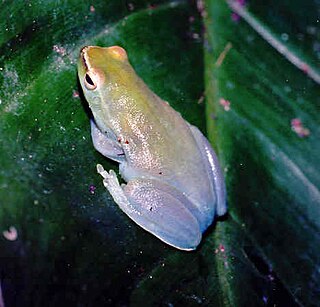
Sphaenorhynchus is a genus of frogs in the family Hylidae. They are also known as lime treefrogs or hatchet-faced treefrogs. They are found in the Amazon and Orinoco River basins of South America, the Guianas, Trinidad, and southern and eastern Brazil. The majority of the species are associated with the Atlantic Forest domain in Brazil.

The canebrake tree frogs are a frog genus Aplastodiscus. They are in the family Hylidae. Residing primarily in southeast regions of Brazil near the Atlantic coast. The exception is the Aplastodiscus perviridis which is found mostly in Brazil, but has also been documented being in Argentina, and might reside in Paraguay. The major revision of the Hylidae genus expanded it to include 12 more species originally from Hyla. Before the revision there were only 2 species. There are currently 16 described species with the most recent addition Aplastodiscus heterophonicus being described in 2021.
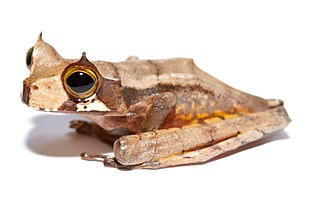
Gastrotheca is a genus of frogs in the family Hemiphractidae. They are found in Central America south of Costa Rica and in South America. Most species occur in the American Cordillera from southern Costa Rica to north-western Argentina. This genus makes up the bulk of marsupial frog diversity; formerly it was placed in the "Leptodactylidae" assemblage.
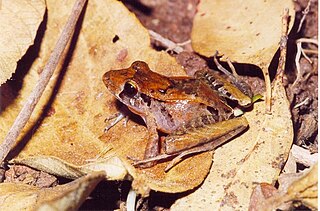
Ischnocnema is a genus of frogs from eastern Brazil and north-eastern Argentina. They comprise the former Eleutherodactylus from this region, but they are closer to Brachycephalus than the "true" Eleutherodactylus. Consequently, they are now placed in their own genus Ischnocnema in the family Brachycephalidae.

Boana is a genus of frogs in the family Hylidae. They are commonly known as gladiator frogs, gladiator treefrogs or Wagler Neotropical treefrogs. These frogs are distributed in the tropical Central and South America from Nicaragua to Argentina, as well as in the Caribbean.
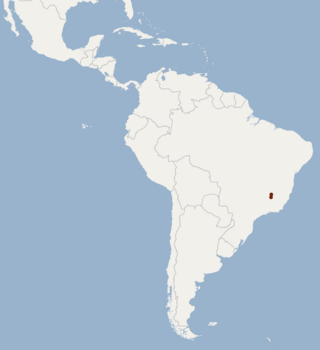
Bokermann's nectar bat is a bat species from South America. It is endemic to Brazil. It feeds on nectar, and is listed as an endangered species.

Dendropsophus branneri is a small hylid tree frog endemic to the Atlantic Forest region of Brazil. It feeds mainly on arthropods and is preyed upon by various invertebrates and vertebrates. Although currently classified by the IUCN Redlist as "least concern", D. branneri suffers rapid habitat loss due to residential development, agriculture, logging, and clearing for pastureland. Male D. branneri are noted for their fighting call, which differs significantly in frequency, duration, and pulses per call compared to their mate advertisement call. Males are also noted for their willingness to escalate physical altercations against other males, which includes kicking, pushing, and wrestling their opponent into non-dominant positions. Unlike most other frog species, D. branneri can breed in both temporary and permanent pools allowing it to inhabit a wide variety of habitats leading to its wide distribution.
The Alagoas heart-tongued frog is a species of frog in the family Hylidae, the tree frogs and allies. It is endemic to Brazil, where it is known from coastal regions in Bahia, Alagoas, and Pernambuco. It has been observed as high as 550 meters above sea level.

Adelophryne maranguapensis is a species of frog in the family Eleutherodactylidae. It is endemic to Serra de Maranguape, just west of Fortaleza, in Ceará state, northeastern Brazil.
Crossodactylodes bokermanni is a species of frog in the family Leptodactylidae. It is endemic to Espírito Santo state of eastern Brazil. While its range is small, it is locally abundant. It is an arboreal species living in forests near 560 m (1,840 ft) altitude. It is associated with epiphytic bromeliads where its tadpoles develop. It is threatened by habitat loss.
Crossodactylodes izecksohni is a species of frog in the family Leptodactylidae. It is endemic to Santa Teresa in Espírito Santo state of eastern Brazil.
Crossodactylodes pintoi is a species of frog in the family Leptodactylidae. It is endemic to Rio de Janeiro and Espírito Santo states of southeastern Brazil, although the latter records may represent another species. This little known species is assumed to be associated with bromeliads, similarly as other Crossodactylodes species. It is probably impacted by habitat loss, including that caused by collecting of bromeliads.
Stereocyclops parkeri is a species of frog in the family Microhylidae. It is endemic to southeastern Brazil and known from the southwestern part of the state of Rio de Janeiro and from Ilha de São Sebastião ("Ilhabela"), São Paulo state. For a period it was treated as a synonym of Stereocyclops incrassatus, but is now recognized as valid species.

The Brazilian gold frog, also known as Izecksohn's toad or flea-frog, is a very small species of frogs in the family Brachycephalidae. It is endemic to southeastern Brazil and is known from the central part of the state of Rio de Janeiro and from Serra das Torres in extreme southern Espírito Santo.
The bromeliad frog (Crossodactylodes) is a genus of frog in the family Leptodactylidae from the Atlantic Forest biome of eastern Brazil.

The Pico do Itambé State Park is a state park in the state of Minas Gerais, Brazil. It protects one of the higher peaks in the state.
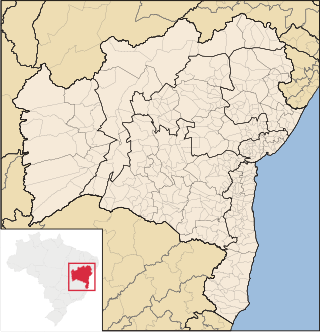
Nyctimantis arapapa, also known as Bahia's broad-snout casque-headed tree frog, is a species of frog endemic to the Atlantic Rainforest of southern Bahia, Brazil. The frogs of the genus Nyctimantis are distinguished by a bony plate on top of their heads, referred to as "casque-headed". Casque-headed frogs are characterized by their phragmotic behavior. N. arapapa is further characterized by the long bill-shaped "snout" they possess, similar to that of Triprion petasatus, a head longer than it is wide, and their small size. This species, and all species of Nyctimantis, use their unique head shape to seal off the leaves of bromeliads, the plant they inhabit solely. This has two known purposes: warding off predators from the frog as well as their young, and trapping moisture.
Coendou speratus, known locally as coandumirim and commonly as the dwarf porcupine, is small porcupine of the Coendou genus found in northeastern Brazil. This small porcupine has a long tail and a spiny appearance as its dorsal fur is not long. Its dorsal colouring is blackish which contrasts with the brownish tips of its quills. It is distinguished from Coendou nycthemera by its tricolored quills whereas nycthemera is bicoloured.
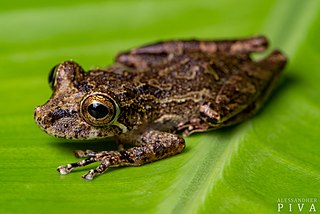
Ololygon is a genus of frogs in the family Hylidae. The majority of species in it are endemic to the Atlantic Forest of eastern Brazil, although the range of some species, including Ololygon aromothyella and Ololygon berthae, is known to extend south to northeastern Argentina, southern Paraguay, and Uruguay.












